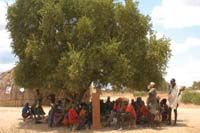Training
Training is a special form of teaching that requires plenty of advance planning. Training refers to the teaching of vocational or practical skills and knowledge that relates to specific useful competencies. Teaching is basically imparting knowledge through learning, while training involves enhancing the skill through practice. It is through training that we can equip the individual and the community with the appropriate skills to deal with a wide variety of health issues. Once you have made contact with relevant community groups, you should help them acquire appropriate training so that they can participate in health education activities (Figure 14.3). Training is particularly important if these groups are newly organised.

Why do you think that it is important to provide training for community members who will participate in health education activities? Do you think they can carry out this responsibility without being provided with appropriate training about ways in which it might be possible to educate their peers?
Community members may lack appropriate knowledge and skills to carry out necessary activities in the health field. Even if they have some information about health issues, they almost certainly will not have all the necessary information and skills to deliver the correct messages. Training will improve their knowledge and skills so they can participate in health education activities.
In the community, you may be able to identify many interested individuals, such as community leaders or religious leaders, kebele administrators, and other committed volunteers and individuals. You should plan how to equip them with appropriate knowledge and skills through training. This can also be a way of getting them to think about other possible health problems in the future. There are several steps that you will have to follow to provide training for existing, or newly organised community groups. These steps are set out in Box 14.2.
Box 14.2 Steps to use when conducting training for organised groups
- Select training participants
- Identify their need for training; identify the knowledge or skill gaps which would benefit from training
- Specify the objectives you intend to achieve through training
- Collect the necessary materials required to conduct the training sessions, including teaching materials and other resources
- Conduct the training session
- Obtain feedback from the participants, so that you can improve your future performance.